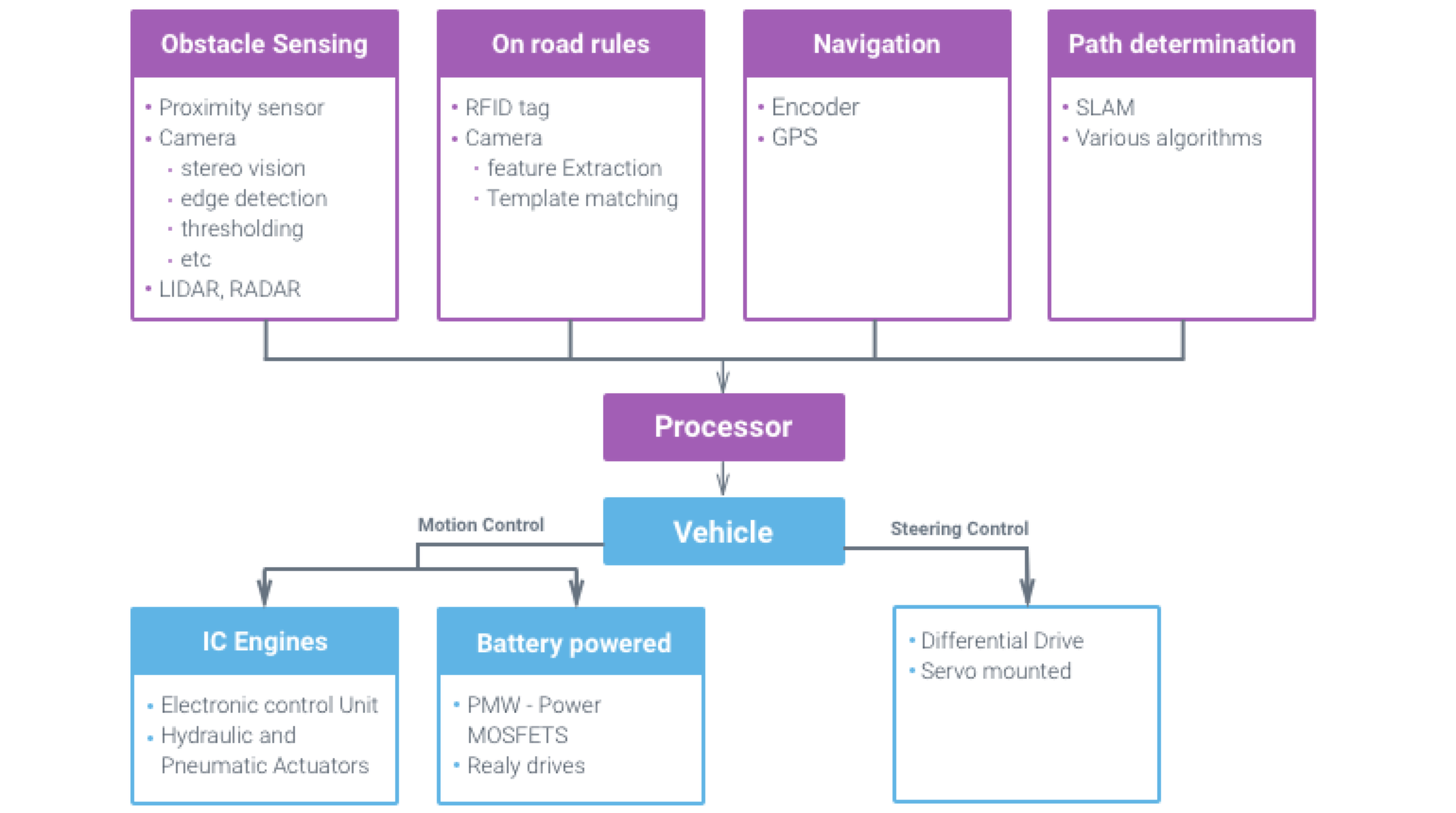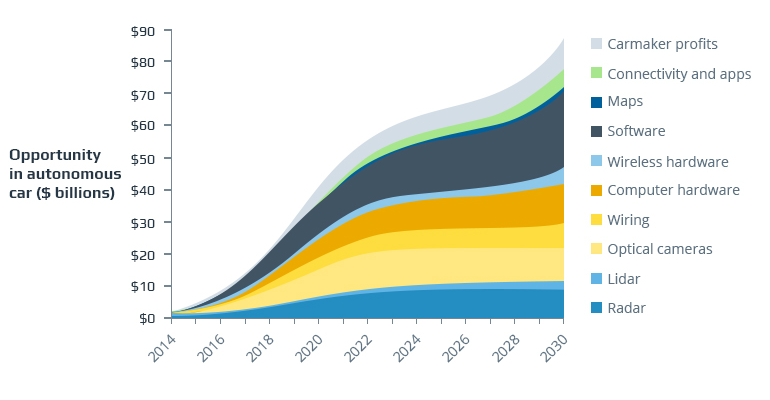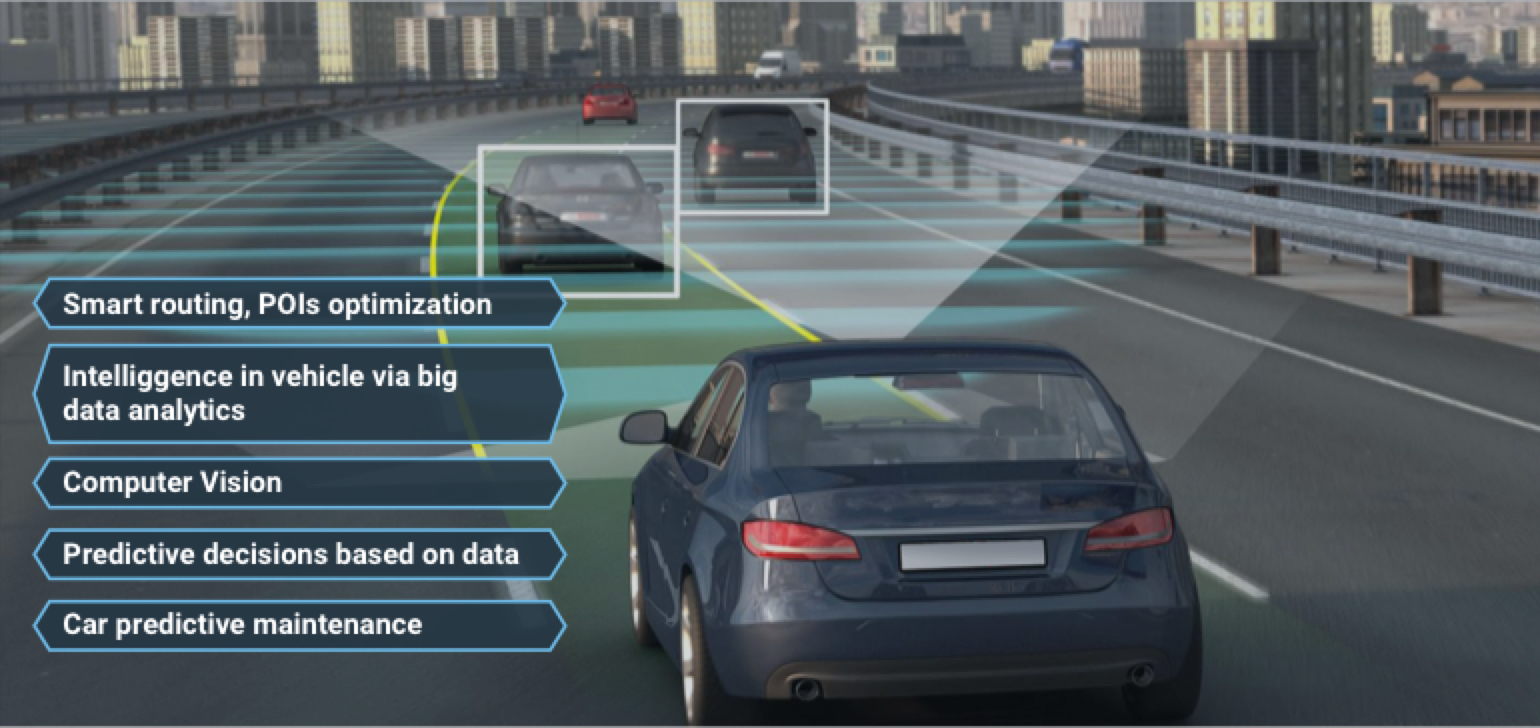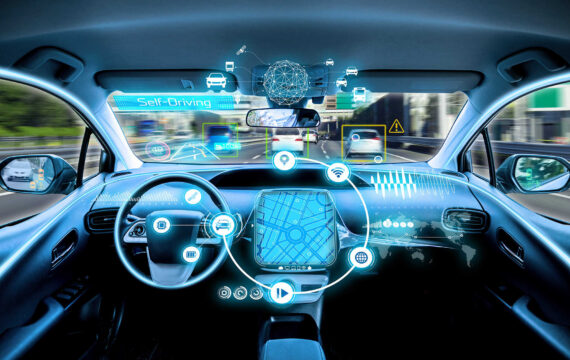Look at your car. It might be the last one you drive on your own. The future of autonomous vehicles already seems irreversible and so close, you just take off the hands of the wheel and enjoy the ride. All the leading car manufacturers promise that autonomous vehicles in the future will conquer the world between 2018 and 2030.
One small step aside the wheel for a human becomes a giant leap for the automotive industry.
Roadmap to autonomous driving

And how will self-driving cars change the way people live? How strong would be their impact?
Autonomous vehicles in the future will offer numerous benefits:
- liberates you when you’re on the road
- saves parking slots in the city
- gives the best option for the POI
- shows where to make an urgent purchase
Intelligent mechanics can save fuel, reduce emissions, ease the flow of traffic, improve transportation, and supply services. Moreover, the future of autonomous vehicles promises to save millions of lives by minimizing accidents caused by human error, making driving experience as safe as enjoyable.
Functional architecture of autonomous cars

Roadblocks to the autonomous future
The biggest challenges to the upcoming autonomous vehicle future fall into three categories:
- Legal
- Ethical
- Technical
Legal and ethical problems are hard to solve because their clues are outside the direct influence of the automotive industry and largely depend on the local governments. On the other hand, autonomous driving technology is improving faster and faster as more OEMs and Tier 1 vendors join the race to create autonomous vehicles in the future.
Technical pillars to autonomous vehicles in the future

Let’s take a closer look at the five technical pillars that stand tall for self-driving cars to come in the immediate future.
Car sensors and software to enable cars see the road
Self-driving car navigation is based on four key elements:

A few years ago, sensor quality and cost were the hot spot of every discussion about the autonomous vehicle future as the potential niche for business investments. Google used a LIDAR system priced at around $75,000 per unit, which was half the total cost – around $150,000 – of each of their driverless vehicles. These prices made self-driving cars a dead weight for the global market because a single travel on a self-driving car was tended to cost impossible sum comparable to owning a private jet.
Since then Velodyne, a company specializing in LIDAR production, has started offering a small but capable unit for just $500, which made the autonomous technology more available. So, the issue of cost as the main roadblock to autonomous vehicles has gradually started to fade away.
Google used a LIDAR system priced at around $75,000 per unit, which was half the total cost – around $150,000 – of each of their driverless vehicles. Now, Velodyne offers it for just $500.
At this stage, the responsibility for our autonomous vehicle future rests primarily with automotive software providers. They have the entire niche to develop an automotive expertise that would meet the autonomous car requirements as its widespread popularization opens a huge demand for software among other opportunities.
Software will capture the largest slice of the autonomous car opportunity

In particular, the software for autonomous driving will be separated into the following categories of expertise:

Navigation and mapping for precise positioning on the road
Relying on sensors, software, and GPS data, an autonomous vehicle processes nearly 4,000 gigabytes of data daily. Advanced machine learning algorithms need timely updated data to react to the ever-changing environment. A continuous exchange of data between vehicles and the cloud can overload data networks and data storage, creating additional challenges for software vendors.

Currently, map providers are putting every effort into reducing the volume of data transferred between a vehicle and the cloud by trying to maximize the amount of car big data processed within the vehicle itself. One proposed solution is a so-called “self-healing map” that would use on-board AI algorithms and deep learning capabilities to navigate without stepping too far to the cloud.

Built-in computer vision algorithms could recognize landmarks and road signs picked up by cameras. This would allow a vehicle to distinguish static objects in the changing environment and generate a detailed 3D picture within the embedded navigation system. Reducing the amount of data exchanged with the cloud would save the data connection primarily for exchanging missing map information among drivers. This would encourage map makers and OEMs to prepare for a new era of crowd-sourced maps.
Machine learning and Open Location platforms to teach cars on-the-go
Most innovative tech companies have introduced their own open location platforms (OLPs) that let a car literally teach itself how to navigate. An OLP can help a car manufacturer equip their current models with advanced driver assistance technologies right away instead of having to design new prototypes. This cross-industry cooperation between tech companies and automakers might dramatically speed up the future of autonomous vehicles.
An OLP can help a car manufacturer equip their current models with advanced driver assistance technologies right away instead of having to design new prototypes.

Collaboration between OLP providers and car makers gives companies the opportunity to collect as much traffic data as possible. With a growing number of cars equipped with OLP, sensors, and even solutions that are considered to be weak AI in automotive, the volume of data on the road environment will increase exponentially.
Instead of driving endless kilometers worldwide with hundreds of mapping cars to collect traffic data to produce high-resolution maps, millions of regular cars connected to an OLP will provide a detailed picture of the world in record time.
With a growing number of cars equipped with OLP, sensors, and powerful AI solutions, the volume of data on the road environment will increase exponentially.

Moreover, with access to traffic data from various sources and industries, an OLP has a much greater potential. An open location platform can connect to a city’s infrastructure, merchants, and suppliers to become one large data hub for map users and drivers. By analyzing where a driver has previously driven, product companies can suggest deals for a potential customer and not just the right turn to take to escape a traffic jam.
An open location platform can connect to a city’s infrastructure, merchants, and suppliers to become one large data hub for map users and drivers.
The accelerated improvement of HD maps will take autonomous driving to the home stretch. Raw data from sensors can be accumulated as a common source of easily accessible data about routes, traffic situations, and environmental changes. The key to landing all this big data in one place is the open location platform.

Connectivity and communication between cars and the environment
The future of autonomous vehicles and connectivity relies largely on building trust between a consumer and a car. Would you be ready to sit in a taxi and entrust your life to an AI without even being aware of how it behaves? The issue of placing trust in a vehicle can be resolved with a car’s communication abilities.
A vehicle should be connected not only to the cloud (to receive geolocation data and map updates), but also to humans (V2H), other vehicles (V2V), and infrastructure (V2I) in order to be trustworthy traffic participants.
Vehicle-to-human (V2H) communication is based on a human-machine interface that enables the driver to observe the vehicle AI’s intention before it makes a move. Based on natural language processing algorithms and voice recognition, V2H communication already simplify interaction experience with navigation infotainment systems and can create an extra link between self-driving cars and their owners.

Vehicle-to-Vehicle (V2V) communication sets autonomous cars on the most efficient and safest course. By communicating with other vehicles, a self-driving car can receive information about upcoming obstacles, traffic congestion, and pedestrians on the road long before they’re in front of the vehicle or appear on the map.
Advanced V2V communication systems will make it much easier for autonomous vehicles to understand traffic behavior. Essentially, this is because vehicles will communicate in their own language among each other. Currently, a vehicle’s AI has to adapt to the human-made system of signs and signals to predict the movements of other human-driven vehicles.
Advanced V2V communication systems will make it much easier for autonomous vehicles to understand traffic behavior.
Vehicle-to-Infrastructure (V2I) communication allows an autonomous car to exchange data with its environment, including with buildings, traffic lights, and road signs. For example, when driving too fast, a car might receive a signal from a traffic light about a possible red-light violation. Or a car might receive a signal about a potential green line for further 30 kilometers if it drives at 50 km/h.

The concept of V2I connectivity brings us closer to smart cities that can spread data-driven decision-making even further than the automotive industry.

Cybersecurity to keep autonomous cars safe from the intruders
Driverless cars are already very smart. But are they smart enough not to be hacked but to guarantee 100% safety? The answer is that they need to become that smart.

The early adoption of an advanced driver assistance system (ADAS) in already existing highly-automated cars, for example, can stop your car when you’re driving into a wall. But do you want your car to stop in the middle of the street without any reason only because of a hack attack? The significance of cybersecurity rises dramatically in a world where a hacker can drive, stop, and control your car remotely.
Properly built security systems can be a strong barrier to halt a thief. If a car’s system detects an abnormality in the vehicle’s behavior, it can block data access or even cut the car connection. In addition, preliminary penetration tests and prediction of possible threat scenarios make the security burden much easier.

Tesla driverless car was intentionally attacked several times a day with the reward ranging from $100 to $10,000 only to find a critical bug or any other potential vulnerability. In one week, Tesla Model S was hacked in a variety of ways, allowing attackers to remotely open the door, change the music, control the air conditioning system, and even start the vehicle. There are many similar examples from other manufacturers. Finding these security holes out in the field conditions can help make autonomous cars more secure.
Tesla driverless car was intentionally attacked several times a day with the reward ranging from $100 to $10,000 only to find a critical bug or any other potential vulnerability.
Car makers and software security providers are forced to work together to prevent risks related to the safety of autonomous vehicles in the future. The best strategy is to create an advanced architecture capable of detecting and preventing penetration or any conflict with standard vehicle algorithms.
Despite the roadblocks, autonomous driving is quickly approaching the global traffic. It promises to change our perception of urban mobility, mapping, supply services, smart cities, and AI capabilities in a larger sense.
In this race, to win the driverless future, the tech part plays the role of a catalyst for a wider span of industries to consider autonomous driving as the most competitive though promising field in the nearest years. Even though autonomous driving is one of the biggest challenges in automotive industry, it’s also making the car-manufacturing domain the benchmark for other industries that are relying on connectivity, embedded solutions, and deep AI integration to drive the future.
At this point, one small step aside the wheel has already been taken. The giant leap that will change the world has just begun.
Intellias is ready to become your trusted partner in autonomous driving development. Get in touch to create the driverless future together.



